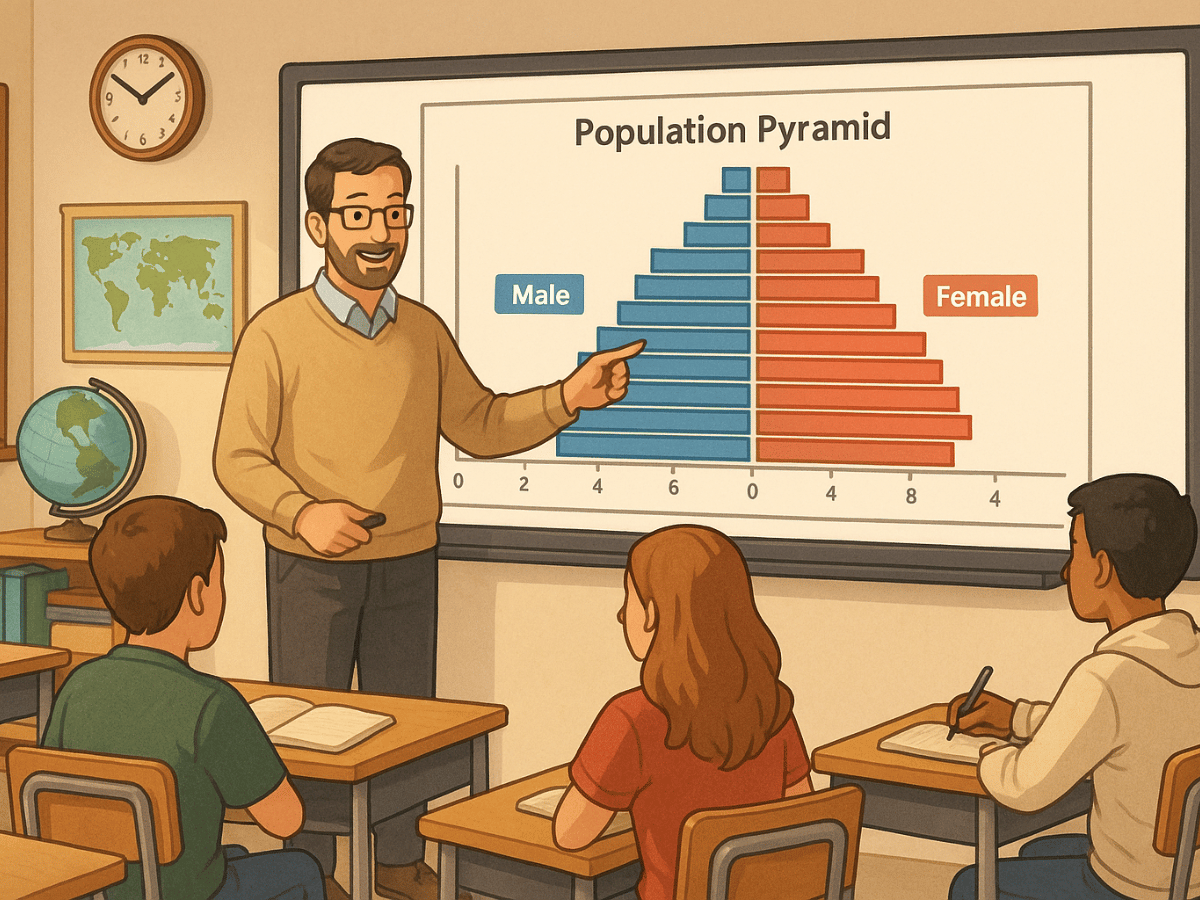I can picture it (because I’ve been there)… You’re two weeks into AP Human Geography Unit 2, and half your class is glazed over. CBR, CDR, NIR, OADR—by the time you get to dependency ratios, they’re drowning in alphabet soup.
Meanwhile, you’re trying to make the Demographic Transition Model feel relevant to kids who think “population crisis” means their phone dying while binging Netflix.
Let me help.
The AP Human Geography Unit 2 Struggle is Real (And It’s Not Your Fault)
We’ve all been there. You’re explaining why birth rates drop in Stage 4 countries, and you get that sea of blank stares that says “Okay. And?”
Or you’re connecting Malthus to modern population policies, and they’re giving you that look that says, “Ma’am, this is 2025, not 1798.”
Meanwhile, the AP exam expects them to analyze population pyramids like they’re reading their horoscope, evaluate migration theories, and synthesize demographic data with economic development patterns.
The real challenge isn’t just the vocabulary overload (though there’s definitely that). It’s that population concepts feel abstract and disconnected from their world.
How do you make demographic transition stages feel as immediate as their social media feeds? How do you get them to see the human drama behind those boring bar graphs?
Here’s the thing: You don’t need to turn into a song-and-dance performer to make Unit 2 engaging. You just need resources that make data visual, human, and compelling enough to penetrate teenage indifference.
If you’re brand new to APHG and feeling overwhelmed by the scope of this course, definitely check out my complete beginner’s guide for new teachers first. It’ll give you the foundation you need to both get started, and finish strong.
Hans Rosling: The GOAT of Data Storytelling
When it comes to making population statistics cool, Hans Rosling was in a league of his own.
His secret wasn’t fancy graphics (though those helped)—it was turning dry numbers into human stories with real stakes. He loved data! And he loved the stories it told.
Even better? His videos hit multiple Unit 2 learning objectives without feeling like textbook torture. The Gapminder Foundation continues his work with updated data tools that can supercharge these lessons.
200 Countries, 200 Years, 4 Minutes
What it is: An animated scatterplot showing life expectancy vs. income over two centuries. Countries appear as bubbles that grow, shrink, and dance across the screen as history unfolds.
How to make it stick: Don’t just hit play and hope for magic. Start with a prediction challenge.
Show them the empty axes. Ask them to sketch what they think will happen. Will all countries move together? Will some race ahead while others lag behind?
Then let them watch their predictions get demolished (or occasionally vindicated).
The magic moment: When students see countries cluster and scatter based on wars, famines, and economic booms, something clicks. The DTM stages stop being memorization and become patterns with real human causes.
Discussion prompt ideas: Why don’t countries move in lockstep? What events cause those dramatic drops or sudden leaps? This connects beautifully to DTM analysis and development contrasts—exactly what shows up on AP exams.
Global Population Growth, Box by Box
What it covers: Population growth toward 9 billion and the counterintuitive truth that rising living standards actually reduce fertility rates. (Yes, your students will be shocked.)
Strategic pause point: Stop the video after Rosling shows the first population “boxes.” Hit them with this: “What policy reduces Total Fertility Rate fastest—education, income, or healthcare?”
Let them argue for 2-3 minutes. Get heated debates going. Then restart the video and watch Rosling’s data blow their assumptions apart.
Level it up: Follow with a quick claim-evidence-reasoning activity. Students pick a side (education, economics, or healthcare) and defend it using examples from the video.
AP connection: This directly targets learning objective 2.4 while setting up discussions about development strategies and women’s roles that pop up throughout the course.
More Videos for AP Human Geography Unit 2
Crash Course: Population, Sustainability, and Malthus (World History #215)
What it tackles: Why Malthus still matters (and where he completely whiffed), population checks, and modern sustainability debates.
Quick win: After viewing, have students create a T-chart: “What Malthus Got Right” vs. “What Malthus Got Wrong.” Takes 5 minutes, generates discussion that can fill the entire period.
Push it further: Connect their conclusions to Boserup’s theory or Stage 5 DTM debates. Ask: “If Malthus underestimated human innovation, what modern breakthroughs did he never see coming?”
Suddenly they’re connecting 19th-century theory to GMOs, vertical farming, renewable energy. Abstract becomes concrete.
“7 Billion” (National Geographic)
What it delivers: The human story behind hitting 7 billion people, focusing on global pressure points and what it means for sustainability.
Exit ticket power move: After viewing, students write: “Name one metric (besides population size) we need to track to judge sustainability—and explain why.”
You’ll get everything from carbon emissions to education access to urban density. Perfect FRQ prep for questions about multiple factors influencing population policies.
TedEd: Population Pyramids
What it teaches: How to decode population pyramids and predict future growth, aging challenges, and policy needs.
Don’t just show it—make it interactive: Give each table group a different pyramid (Germany, Nigeria, China, UAE, etc.). Have them:
- Describe the shape using proper vocabulary
- Identify the DTM stage and justify their reasoning
- Predict one major challenge this country will face
- Compare findings with another group
- Write a newspaper headline that captures their country’s demographic story
Assessment goldmine: Walk around and listen. Their discussions reveal DTM understanding, identify misconceptions, and show you what needs reinforcing.
Want more ideas for making your classroom interactive from day one? Check out my proven first-day activities that set the engagement tone for the entire year. (Many of these you can use all year long).
FREE AP Human Geography Unit 2 Activity
Thanks for reading this far! I would love to reward your commitment to better teaching with something that’ll actually save you time and boost engagement in your classroom.
The fastest way to move students beyond vocabulary memorization? Show them demographic theories playing out in real time through current events.
That’s exactly what my Japan Population Decline Activity does. Built around the recent CNN article “Japan’s population decline keeps getting worse,” this resource tackles every APHG teacher’s challenge: making demographic transition feel urgent and relevant.
Why Japan is the Perfect Case Study
Japan isn’t just another country example—it’s a demographic time machine. Students see Stage 5 DTM in action, witness the real-world impacts of population aging, and evaluate how governments respond when birth rates tank.
Plus, Japan’s situation connects naturally to multiple CED topics without feeling forced or artificial.
The Activity in a Nutshell
It’s not revolutionary or especially fancy. It simply provides two types of scaffolded questions:
“Did you read it?” comprehension checks that hold students accountable for engaging with the article. These cover birth vs. death data, Japan’s immigration policies, and government efforts to reverse population decline.
AP Human Geography course connections that push toward the higher-level analysis the exam demands. Students place Japan on the DTM, predict specific aging challenges, evaluate pronatalist policy effectiveness, and assess immigration as a demographic solution.
These questions align directly with CED topics 2.2, 2.4, 2.5, 2.7, 2.8, 2.9, and 2.12. (Translation: this isn’t just busy work.)
How to Implement the Freebie
Start with the article as homework or bell-ringer reading. Use the comprehension questions to ensure everyone has basic facts straight.
Then deploy the analysis questions for class discussion, small group work, or individual assessment.
Here’s where it gets good: Students start making connections. Japan’s challenges mirror South Korea, Italy, parts of Eastern Europe. They’re not just studying one country—they’re recognizing global demographic patterns.
Pro move: After students complete the Japan analysis, have them research another Stage 5 country and compare responses. Germany vs. Japan? Singapore vs. South Korea?
This comparative analysis is exactly what successful AP students do on exam day.
General Strategy Advice
These resources work because they make abstract concepts concrete. But how you use them matters more than what you use.
Start with predictions: Before any video, get students to predict outcomes. Wrong predictions are still helpful as they create cognitive dissonance that makes learning stick.
Pause strategically: Don’t just press play and pray. Pause at key moments to check understanding, process information, or set up the next section.
Connect across units: These population concepts resurface in Units 6 and 7. When teaching urbanization or development, callback to these videos. Students love recognizing patterns.
Vocabulary in context: Skip the front-loading. Let students encounter terms naturally through videos, then formalize definitions. Better retention, less resistance.
Need more resources for Unit 2? Or maybe you’re looking for the complete roadmap? My comprehensive APHG resource collection includes everything you need to teach the entire course from bell-ringers to slides to assessments for every single unit – including Unit 2.
Ready to Transform Your Unit 2?
Unit 2 doesn’t have to be a vocabulary death march. With the right resources, students start seeing population data as human stories, demographic patterns as historical forces, and migration theories as tools for understanding their world.
The Japan Population Decline Activity is your perfect starting point. It’s completely free, directly aligned with the CED, and designed to generate the analytical thinking that shows up on successful AP exams.



No responses yet